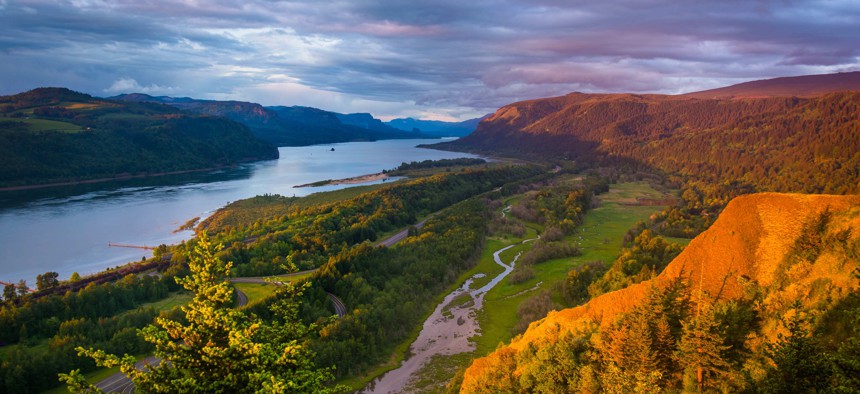Transit to the Trailhead: Bus Service in a Recreation Corridor Takes Off

Shutterstock
Oregon’s Department of Transportation has seen strong demand among riders for buses that run between Portland and the Columbia River Gorge.
Traffic congestion can get thick along the Interstate 84 corridor, east of Portland, Oregon in the Columbia River Gorge—especially in warmer months when the weather is nice.
The scenic area is a magnet for people looking to spend time in the outdoors, but it’s also an important conduit for east and west bound trucks carrying freight.
Aiming to help reduce the number of cars passing through, Oregon’s transportation department about three years ago worked with the U.S. Forest Service to launch a bus line that now runs between a transit center in Portland and various destinations in the gorge.
It’s proven to be quite popular. “It seems that we’re just not able to meet the demand,” said Valerie Egon, program manager for the Columbia Gorge Express. “The more service we provide the more people are using it,” she added.
The gorge is a dramatic river canyon on the Oregon-Washington border, about 80 miles long and 4,000 feet deep in some places. It’s formed where the Columbia carves through the Cascade mountains, near the end of its roughly 1,200 mile path to the Pacific Ocean.
People visit the area for all sorts of recreation.
Multnomah Falls, a 611-foot waterfall, is a big draw. The city of Hood River is a mecca for windsurfing and kiteboarding. Cycling, breweries, wineries and orchards attract people as well. Mt. Hood and Mt. Adams, two iconic, glacier-caked Pacific Northwest volcanoes, stand sentinel over the region to the south and north.
“People who are visiting natural areas, they really want to support sustainable and environmental and conservation programs or activities,” Egon said. “Being able to take transit to those areas I think is a way for people to know that they can make that choice.”
Kevin Gorman, executive director of the group Friends of the Columbia Gorge, warned earlier this year that visitation to the gorge was so robust that there was a growing risk of “loving it to death.” He cited visitors traveling to the gorge by car as a key concern.
Gorman applauded public transit options like the state-run bus, but also voiced support for a more comprehensive approach to the growing congestion.
The bus service launched in 2016, but only ran that year on weekends and holidays from May to September. There were close to 29,000 boardings during that time. The next year, service was cut short due to a large wildfire that tore through parts of the gorge.
But in 2018 it resumed, with buses running year-round seven days a week, and service extended to the cities of Cascade Locks and Hood River. Boardings increased to nearly 90,000 and are on track to surpass that level this year, according to Egon.
“On the busiest days we may see up to a thousand boardings,” she said.
A big challenge with the program has been marketing. “Since so many of our riders are tourists, it’s just a really hard market to reach,” Egon said. Many residents don’t know about the program either. “A lot of people learn about the service once they’re already in the gorge.”
Ridership can also depend heavily on the weather, with buses running short on space on nice days, and carrying few passengers on drearier ones. At peak times, four dedicated buses run on the line. A contractor operates them for the state.
The fare between Portland and the east end of the bus line in Hood River is $7.50 each way.
Most of the funding for the program for 2016 through September 2020 came from what’s known as the Federal Lands Access Program. This federal funding totaled roughly $3.5 million. The state, along with local partners, chipped in a 10% match on that amount.
Egon explained that the state didn’t view the federal dollars as a source of permanent funding, but rather a financial boost to get the program off the ground.
As federal support winds down, the state is moving toward an arrangement with a local transit agency in the Hood River area to continue operating buses between cities on the route.
The state, however, will continue to run a shuttle service that has been part of the program, which ferries people in spring and summer months between Multnomah Falls and a nearby parking area.
Egon noted that one downside of the service is that if traffic is bad, the buses can get caught in it as well. “There is still congestion in the area,” she said. “I think to really have a more robust and successful program in the long-term, you really need to prioritize transit.”
Bill Lucia is a Senior Reporter for Route Fifty and is based in Olympia, Washington.
NEXT STORY: How transparency and visibility are reshaping public safety






